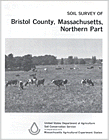Soil Survey of Bristol County, Massachusetts
NORTHERN PART

The following Map Unit Description is from the 1981 Soil Survey of Bristol County, NORTHERN Part. Please note: map unit symbols are DIFFERENT for Bristol North and Bristol South reports, do NOT use these descriptions for Bristol South.
Wc-Wareham loamy sand. This soil is deep, nearly level, and poorly drained. It is on sandy glacial outwash. Slopes are smooth or very gently undulating, and are 100 to 200 feet long. The mapped areas are irregular in shape and range from 5 to 15 acres in size.
Typically, the surface layer is very friable, very dark grayish brown loamy sand about 6 inches thick. The subsoil is loose, loamy coarse sand about 30 inches thick. The upper 10 inches of the subsoil is yellowish brown, and the lower 20 inches is light brownish gray. The subsoil is mottled in yellowish red, strong brown, and light brownish gray. The substratum to a depth of 60 inches is loose, pale olive coarse sand that is mottled in brown and light olive brown.
Included with this soil in mapping are areas of Walpole, Scarboro, and Pipestone soils that are generally less than 4 acres in size. Also included are a few small areas of soils that have gentle slopes, and areas of soils that have a gravelly substratum. The included soils make up about 20 percent of the map unit.
Permeability is rapid, and available water capacity is low. Reaction ranges from strongly acid to extremely acid. The root zone is restricted by a seasonal high water table which is at or near the surface 6 to 8 months of the year.
This soil has poor potential for farming, urban use, sanitary waste disposal facilities, and trees. The potential is fair for openland and wetland wildlife habitat. Most acreage is in woodland.
The soil is poorly suited to cultivated crops. It is moderately suited to moisture-tolerant hay and pasture plants. The soil can be drained and used for cropland if suitable outlets are available. Conservation management includes installing field drainage where feasible and appropriate timing of farming operations. Good tilth and organic-matter content are easy to maintain. Proper stocking rates, deferred grazing, and pasture rotation help to maintain desirable plant species.
The soil has limitations for trees, and productivity is low. Important tree species are red maple and eastern white pine.
The soil has limitations for most urban use and for sanitary waste disposal facilities. The seasonal high water table and rapid permeability are limitations. Capability subclass IVw.